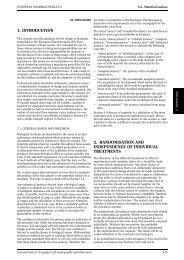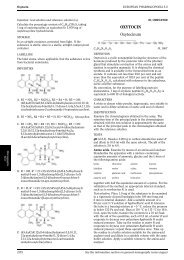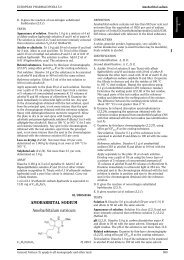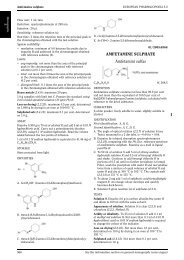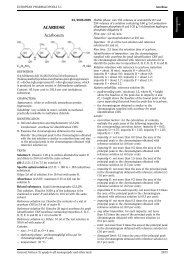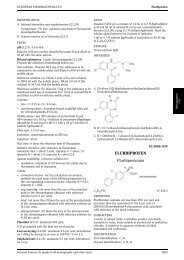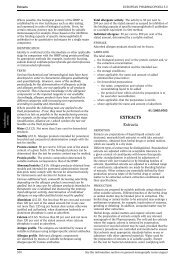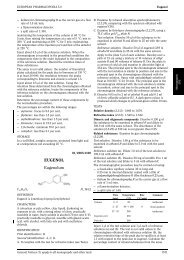TRAGACANTH Tragacantha
TRAGACANTH Tragacantha
TRAGACANTH Tragacantha
You also want an ePaper? Increase the reach of your titles
YUMPU automatically turns print PDFs into web optimized ePapers that Google loves.
EUROPEAN PHARMACOPOEIA 5.0 Tramadol hydrochloride<br />
Microbial contamination. Total viable aerobic count (2.6.12)<br />
not more than 10 4 micro-organisms per gram, determined by<br />
plate count. It complies with the tests for Escherichia coli<br />
and Salmonella (2.6.13).<br />
STORAGE<br />
Store protected from light.<br />
LABELLING<br />
The label states whether or not the contents are suitable for<br />
preparing emulsions.<br />
01/2005:1681<br />
TRAMADOL HYDROCHLORIDE<br />
Tramadoli hydrochloridum<br />
C16H26ClNO2 Mr 299.8<br />
DEFINITION<br />
(1RS,2RS)-2-[(Dimethylamino)methyl]-1-(3methoxyphenyl)cyclohexanol<br />
hydrochloride.<br />
Content: 99.0 per cent to 101.0 per cent (anhydrous<br />
substance).<br />
CHARACTERS<br />
Appearance: white,crystallinepowder.<br />
Solubility: freely soluble in water and in methanol, very<br />
slightly soluble in acetone.<br />
IDENTIFICATION<br />
First identification: B, D.<br />
Second identification: A, C, D.<br />
A. Melting point (2.2.14): 180 °C to 184 °C.<br />
B. Infrared absorption spectrophotometry (2.2.24).<br />
Comparison: tramadol hydrochloride CRS.<br />
C. Chromatograms obtained in the test for impurity E.<br />
Results: the principal spot in the chromatogram obtained<br />
with test solution (b) is similar in position and size to<br />
the principal spot in the chromatogram obtained with<br />
reference solution (a).<br />
D. It gives reaction (a) of chlorides (2.3.1).<br />
TESTS<br />
Solution S. Dissolve 1.0 g in water R and dilute to 20 ml<br />
withthesamesolvent.<br />
Appearance of solution. Solution S is clear (2.2.1) and<br />
colourless (2.2.2, Method II).<br />
Acidity. To10mlofsolutionS,add0.2mlofmethyl red<br />
solution R and 0.2 ml of 0.01 M hydrochloric acid. The<br />
solution is red. Not more than 0.4 ml of 0.01 M sodium<br />
hydroxide is required to change the colour of the indicator<br />
to yellow.<br />
Optical rotation (2.2.7): −0.10° to + 0.10°, determined on<br />
solution S.<br />
Impurity E. Thin-layer chromatography (2.2.27).<br />
Test solution (a). Dissolve 0.10 g in methanol R and dilute<br />
to 2 ml with the same solvent.<br />
Test solution (b). Dilute 1 ml of test solution (a) to 10 ml<br />
with methanol R.<br />
Reference solution (a). Dissolve25mgoftramadol<br />
hydrochloride CRS in methanol R and dilute to 5 ml with<br />
the same solvent.<br />
Reference solution (b). Dissolve5mgoftramadol<br />
impurity E CRS in 5 ml of methanol R. Dilute1mlofthe<br />
solution to 10 ml with methanol R.<br />
Reference solution (c). Dissolve 5 mg of tramadol<br />
impurity A CRS in 1 ml of reference solution (a).<br />
Plate: TLC silica gel F 254 plate R, prewashedwith<br />
methanol R.<br />
Mobile phase: concentrated ammonia R, 2-propanol R,<br />
toluene R (1:19:80 V/V/V).<br />
Application: 10µl.<br />
Development: over 2/3 of the plate. Saturate the plate<br />
for 20 min with concentrated ammonia R. Forthis,add<br />
concentrated ammonia R to one trough of a twin trough<br />
tank. Just before developing, add the mobile phase to the<br />
other trough. Place the plate in the chromatographic tank,<br />
ensuring that the layer of silica gel is orientated towards the<br />
middle of the tank.<br />
Drying: inair.<br />
Detection:exposetheplatetoiodinevapourfor1h,examine<br />
in ultraviolet light at 254 nm.<br />
System suitability: the chromatogram obtained with<br />
reference solution (c) shows 2 clearly separated spots.<br />
Limit: in the chromatogram obtained with test solution (a):<br />
— impurity E: any spot corresponding to impurity E is<br />
not more intense and not greater than the spot in the<br />
chromatogram obtained with reference solution (b)<br />
(0.2 per cent).<br />
Related substances. Liquidchromatography(2.2.29).<br />
Test solution. Dissolve0.15gofthesubstancetobe<br />
examined in the mobile phase and dilute to 100 ml with the<br />
mobile phase.<br />
Reference solution (a). Dilute2.0mlofthetestsolutionto<br />
10.0mlwiththemobilephase.Dilute1.0mlofthissolution<br />
to 100 ml with the mobile phase.<br />
Reference solution (b). Dissolve5mgoftramadol<br />
impurityACRSin 4.0 ml of the test solution and dilute to<br />
100 ml with the mobile phase.<br />
Column:<br />
— size: l =0.25m,Ø=4.0mm,<br />
— stationary phase: base-deactivated end-capped octylsilyl<br />
silica gel for chromatography R (5 µm).<br />
Mobile phase: 295volumesofacetonitrile R and<br />
705 volumes of a mixture of 0.2 ml of trifluoroacetic acid R<br />
and 100 ml of water R.<br />
Flow rate: 1.0ml/min.<br />
Detection: spectrophotometer at 270 nm.<br />
Injection: 20µl.<br />
Run time: 4 times the retention time of tramadol.<br />
Relative retention with reference to tramadol (retention<br />
time=about5min):impurityA=about0.85.<br />
System suitability: reference solution (b):<br />
— resolution: minimum 2.0 between the peaks due to<br />
impurity A and tramadol.<br />
GeneralNotices(1)applytoallmonographsandothertexts 2607



